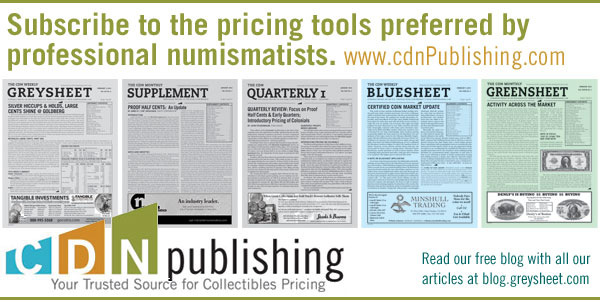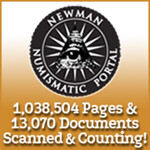
About UsThe Numismatic Bibliomania Society is a non-profit organization devoted to the study and enjoyment of numismatic literature. For more information please see our web site at coinbooks.org SubscriptionsThose wishing to become new E-Sylum subscribers (or wishing to Unsubscribe) can go to the following web page link MembershipThere is a membership application available on the web site Membership Application To join, print the application and return it with your check to the address printed on the application. Print/Digital membership is $40 to addresses in the U.S., and $60 elsewhere. A digital-only membership is available for $25. For those without web access, write to: Terry White, Treasurer
AsylumFor Asylum mailing address changes and other membership questions, contact Terry at this email address: terrywhite5475@yahoo.com SubmissionsTo submit items for publication in The E-Sylum, just Reply to this message, or write to the Editor at this address: whomren@gmail.com BUY THE BOOK BEFORE THE COINSale Calendar
|
- WAYNE'S WORDS: THE E-SYLUM MAY 14, 2017
- NEW BOOK: 1802 HALF DIMES
- NEW BOOK: TRAVERSING TRAVANCORE THROUGH COINS
- BOOK UPDATE: BANKNOTE BOOK 6TH ANNIVERSARY
- BOOK REVIEW: EL NUMISCADERO
- BOOK REVIEW: ART OF DEVASTATION
- DIGITIZED: THE N.A.S.C. QUARTERLY
- DIGITIZED: THE MONEY TREE’S OUT ON A LIMB
- NOTES FROM E-SYLUM READERS: MAY 14, 2017
- EARLY AMERICAN CALENDAR MEDALS
- VOCABULARY TERM: DOUBLE STRUCK
- WALTER B. GOULD (1848-1932)
- PRINCETON ACQUIRES BYZANTINE COIN COLLECTION
- DAHLONEGA MINT GOLD COIN SET EXHIBIT
- GOLDBERGS OFFER ECKFELDT FAMILY MATERIAL
- NUMISMATIC NUGGETS: MAY 14, 2017
- WAYNE'S NUMISMATIC DIARY: MAY 14, 2017
- CHOPMARK NEWS EXAMINES CHOPMARKED TRADE DOLLARS
- CHOPPED CHINESE COPPER CAST COINS
- DICK JOHNSON ON THE CURRENCY OPTIMIZATION ACT
- TOY BANKS IN JUNE 2017 BERTOIA SALE
- POLYMER BANKNOTES CUTTING DRUGGIE NOSES
Click here to access the complete archive
To comment or submit articles, reply to whomren@gmail.com
Content presented in The E-Sylum is not necessarily researched or independently fact-checked, and views expressed do not necessarily represent those of the Numismatic Bibliomania Society.
WAYNE'S WORDS: THE E-SYLUM MAY 14, 2017
 New subscribers this week include: Southern Idaho Coin Club members Randy Ashton, Greg Barnett, Larry Bennett, Jeff Black, Dennis Holladay, Susan Stacy, Dave Thompson, and Frank Villalon
courtesy of John Mutch.
New subscribers this week include: Southern Idaho Coin Club members Randy Ashton, Greg Barnett, Larry Bennett, Jeff Black, Dennis Holladay, Susan Stacy, Dave Thompson, and Frank Villalon
courtesy of John Mutch.
Also: Hasan Alsabea, Didier Collinet, Dave Juriansz, Jan Ove Larsen, Mani Maran, Jack Pierron, Amirali Somji, Nikolaj Vladimirov and Brian Woodcraft.
Thanks to John Mutch for his recruiting efforts! Welcome aboard, everyone! We now have 3,247 subscribers.
I'm publishing an early and abbreviated issue today due to an internet outage. I'm completing the issue at our nearby Panera so we can take my wife and her Mom out for a nice Mother's Day dinner tonight.
I'll work on getting some of the backlog into next week's issue, but be aware that issue may be late - we'll all be on the road for a family wedding. Life gets in the way of numismatics sometimes, but keep your emails and submissions coming.
Thank you for reading The E-Sylum. If you enjoy it, please send me the email addresses of friends you think may enjoy it as well and I'll send them a subscription with your compliments. Contact me at whomren@gmail.com anytime regarding your subscription, or questions, comments or suggestions about our content.
Lots of twos today. This week we open with two new books, two reviews, and two great additions to the Newman Numismatic Portal. Other topics this week include two new museum donations, early calendar medals, the Eckfeldt family collection, chopmarked trade dollars and cast copper coins, and toy banks.
To learn more about 1802 Half Dimes, Ken Lowe, Walter Gould, hemerologe medals, Dahlonega Mint gold, the Young America Furnace Company, ‘getting Winstoned’ and the King of England who could barely speak English, read on. Have a great week, everyone!
Wayne Homren
Editor, The E-Sylum

NEW BOOK: 1802 HALF DIMES
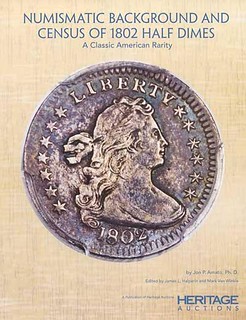 The 1802 half dime is one of the great rarities in U.S. numismatics. It is without a doubt the key date early half dime. Despite its notoriety as a classic numismatic rarity, less is known
about the 1802 half dime’s mintage and survival rate than that of many other rare American coins … until now.
The 1802 half dime is one of the great rarities in U.S. numismatics. It is without a doubt the key date early half dime. Despite its notoriety as a classic numismatic rarity, less is known
about the 1802 half dime’s mintage and survival rate than that of many other rare American coins … until now.
The new book Numismatic Background and Census of 1802 Half Dimes: A Classic American Rarity (Ivy Press, 2017) by Jon P. Amato documents the known examples of this important coin issue, including their level of preservation, provenance and their prices realized at auction.
“Collectors seeking to acquire one of these coveted rarities will have some idea of how many pieces exist in the various grade levels, and how much they might expect to pay for a particular specimen when it appears on the market,” Amato said.
The 64-page book chronicles the lone die pair used to strike all known 1802 half dimes, as well as the number of coins known to be struck by the U.S. Mint. Extensively researched, Amato went back to auction records as early as 1859 to document the 167 appearances of this issue for the nearly 140-year period ending in 1998.
“This is an extremely elusive coin and I wanted this book to put the known specimens in context while also offering collectors images of the known specimens,” Amato said. “This book will appeal to all numismatic collectors who are curious about this classic rarity.”
Numismatic Background and Census of 1802 Half Dimes: A Classic American Rarity by Jon P. Amato, Ph. D., edited by James L. Halperin and Mark Van Winkle, is available from Ivy Press for $29.95 at HA.com.

NEW BOOK: TRAVERSING TRAVANCORE THROUGH COINS
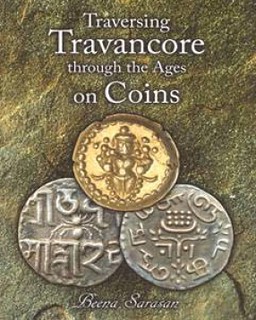 This book attempts to identify coins of the erstwhile princely state of Travancore against their historical background and in the course, illustrates coins that have a bearing on Travancore
history.In short short, the history of Travancore is glimpsed through coins.
This book attempts to identify coins of the erstwhile princely state of Travancore against their historical background and in the course, illustrates coins that have a bearing on Travancore
history.In short short, the history of Travancore is glimpsed through coins.
The identification and attribution of Venad / Travancore coins on the basis of the emblems depicted on the stone inscriptions of Venad rulers and by comparison with the contemporary coinage and seals of neighbouring kingdoms, was for the first time taken up by the author who has published several research papers.this book is the compilation of the outcome of painstaking research spanning two decades.
Authors (s): Beena Sarasan (Author)
Format: Hardcover
ISBN-10: 8130017784
ISBN-13: 9788130017785
Pages: 210p., Colour; Plates
Pub. date: 17.10.2016, 2nd. revi. ed.
Publisher: Poorna Publications
Language (s): English
Bagchee ID: BB104253
List price: US $ 225,00
Bagchee price: US $ 202,50
Member price: US $ 182,25
To read the complete article, see:
Traversing Travancore through the Ages on Coins
(www.bagchee.com/books/BB104253/traversing-travancore-through-the-ages-on-coins)
THE BOOK BAZARRE
BOOK UPDATE: BANKNOTE BOOK 6TH ANNIVERSARY
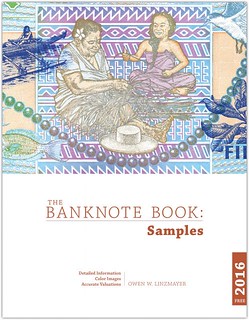 After many years of preparation, six years ago this week I began publishing The Banknote Book with an initial release of 10 chapters. Since then, the catalog has swelled to 252
chapters, with a total of 3,890 pages covering 39,042 types and varieties.
After many years of preparation, six years ago this week I began publishing The Banknote Book with an initial release of 10 chapters. Since then, the catalog has swelled to 252
chapters, with a total of 3,890 pages covering 39,042 types and varieties.
I'd like to thank everyone who has helped reach this milestone, especially the many subscribers and contributors who've spent countless hours scanning their collections, sharing information, and reviewing drafts to ensure the catalog is as accurate as possible.
If you're not already a subscriber, please join today. For as little as US$55, you get access to everything currently available plus future releases, and your provide financial support for the on-going efforts to complete coverage of the entire world.
If you are fortunate enough that you can afford to collect money as a hobby, you can't afford not to subscribe to The Banknote Book.
Revisions to the following have been published in the past week:
- Arab Republic of Yemen (updated prices throughout; added listing for B101as)
- China (added listing for B4048bs)
- Democratic Republic of Yemen (updated prices throughout)
- Fiji (improved illustration for B531)
- Madagascar (added listing for B327c)
- Maldives (added listings for B215as, B223a)
- Moldova (improved illustration for B123)
- Nigeria (added listing for B234i)
- Samoa (added listings for B101as1/2, B102as1/2, B103as1/2, B104as1/2)
- Sierra Leone (added listing for B128b)
- South Arabia (updated prices throughout)
- South Sudan (added listing for B110b; updated Pick cross-references)
- Sri Lanka (added listing for B124c, B126c)
- Straits Settlements (added listings for B101as1/2, B116as)
- Suriname (added listings for B516as, B517as, B518as, B519as)
- Switzerland (added listing for B356)
- Taiwan (added listing for B309ap)
- Trinidad and Tobago (added listings for B108a1s, B203bs, B203cs1/2, B204as1/2, B204bs, B204cs1/2, B204p1/2, B208as)
- Turkey (added listings for B301c, B306b)
- Uganda (added listings for B104ap, B154e/es)
- United Arab Emirates (added listing for B213as)
- Western Samoa (added listings for B402as, B404as)
- Yemen (updated prices throughout; added listings for B101as, B106as1/2, B112as)
If you've previously purchased any of the above chapters, you are entitled to free revisions of your content for a period of one year following your purchase. As always, subscribers are entitled to all revisions as long as your subscription is valid.
For more information, or to order, see:
http://banknotebook.contentshelf.com/shop
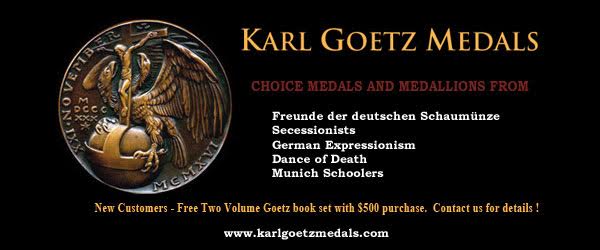
BOOK REVIEW: EL NUMISCADERO
Book Review: El Numiscadero by Gary Beals
 Beals, Gary; El Numiscadero – English to Spanish – Spanish to English Numismatic Dictionary, (Privately printed), Segovia, Spain, and San Diego, CA, 2016, (4), 354 (1) pp., illustr.
ISBN 978-0- 86549-950- 8.
Beals, Gary; El Numiscadero – English to Spanish – Spanish to English Numismatic Dictionary, (Privately printed), Segovia, Spain, and San Diego, CA, 2016, (4), 354 (1) pp., illustr.
ISBN 978-0- 86549-950- 8.
This magnificent, richly illustrated octavo-sized work is the vastly expanded second edition of Gary Beals’ first efforts in this direction, his Numismatic Terms of Spain and Spanish America, first published in early 1966. The dictionary presents a significant compendium of the language of numismatics in both English and Spanish, and is a must for anybody who collects, deals in or researches the coins of Latin America or Spain. A detailed foreword and introduction describe how to use the book.
El Numiscadero also contains several useful lists that have an impact on numismatics, such as on the monarchs of Great Britain and Spain, Roman emperors, popes, Spanish mint officials and their functions, coin and medal shapes, numismatic associations and other topics. Hundreds of words are defined, in alphabetical order of course, including many commonly used abbreviations and slang terms. It is a highly useful work, both for the scholarly researcher and translator as well as for the casual collector who might ask “qué es un slab?” I have been using it extensively for my latest project, which is a translation of Jorge Proctor’s lengthy treatise on the billon coinage of colonial Spanish America, soon to be published in the NI Bulletin. You will of course find terms such as “vellón rico” (billon with a higher silver content, but still under 10%) and other seemingly more mundane terms such as “cuño” which, however, are possessed of great subtlety in that their meaning depends entirely upon context. Cuño in Spanish can mean a coining die (troquel) or an anvil die set in a stump with its matching hammer die (a pile) or even an entire mint!
Now, as with any work of this nature, it is necessarily never entirely complete, and Mr. Beals encourages readers to send in terms or additional definitions that he might have overlooked. Also, if I have to quibble and find fault with something in order to make this a balanced review, the only things I might point out are that the font is a touch too small (for my old eyes), the illustrations are not of very high resolution and the heavy card covers with flaps in a perfect binding may be a trifle fragile for an oft-consulted book. Nevertheless, this allows the book to stay octavo-sized and be carried easily, store on any shelf and not break the bank when you buy it, which I believe you should do at your earliest opportunity, as only 1,000 copies were printed.
Cost is $25 plus $3 shipping within USA; send Gary a check at address below. Books will be shipped from San Diego, CA. For purchasers in Europe, the books will be shipped from Segovia, Spain. Gary adds the following important note: “PayPal does not work internationally since I am in Spain and my CitiBank is in USA.” Instead, for European buyers, contact him and he will supply Bankia transfer information for payment. Contact Gary at: segovia.gary@yahoo.com
Gary Beals, Director
Fortaleza Experiencias Medievales
Calle Roble 10B 1 E
Segovia 40002
SPAIN
tel: +34-921- 413138 +34-628- 506400
To read the earlier E-Sylum article, see:
NEW BOOK: EL NUMISCADERO (www.coinbooks.org/v20/esylum_v20n03a02.html)
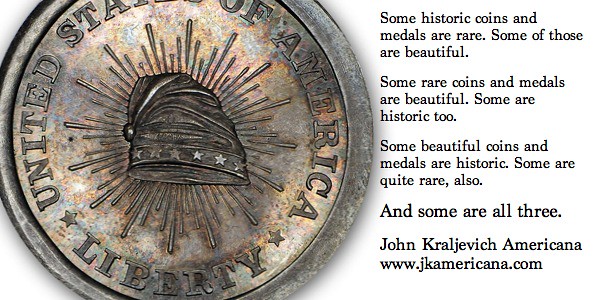
BOOK REVIEW: ART OF DEVASTATION
Both the Philadelphia exhibition and the recent one at Vassar, “The Art of Devastation,” showed numerous posters from the period, none more striking than Fred Spear’s image of a woman underwater, drowning with her baby in her arms. The text on the poster is one word: Enlist. The unspoken reference is to the sinking of the Lusitania, an event that made it hard for America to stay out of the war. You must fight, says the poster, because motherhood is under attack. And another poster says: you must buy bonds in the Fourth Liberty Loan, because the Germans are raping women. “Destroy This Mad Brute, Enlist,” says a third, showing a Prussian ape with a cudgel marked “Kultur” and a bare-breasted woman swooning in his grasp.
It is striking how often in this period the war is presented as an issue of manhood, of womanly values, motherhood, virginity at stake, plain old sex. The woman’s point of view was instantly co-opted.
This sexualization of the war was surely something new. In German propaganda it reached its ultimate expression in a medal designed by Karl Goetz and protesting the French occupation of the Ruhr, in which the usual allegorical victim-woman is tied to a giant erect phallus.
The word “medal” in this sense refers not to military decorations or medals given as awards in competitions, but to commemorative medals—coin-like disks with no fixed monetary value, cast or struck usually in metal, to commemorate or comment upon recent events. The tradition goes back to the Renaissance, when the master medallist was Pisanello. At various times subsequently people introduced a satirical or overtly propagandistic element to the medal, and during World War I this tradition was particularly strong in Germany.
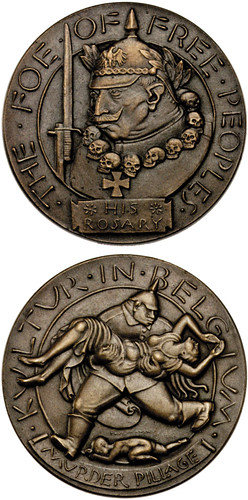 It was an idiom that the American sculptor Paul Manship found to lie perfectly within his grasp, and his medal, “The Foe of Free Peoples,” looks at first glance very like a German medal.
But it is anti-German. On the obverse, Kaiser Wilhelm II is depicted with a helmet, wreath, and rosary of skulls, together with a bayonet. On the reverse, the text reads “Kultur in Belgium, Murder
Pillage.” The Kaiser is seen running off with a woman in his arms, while a child lies on the ground beneath, presumably dead.
It was an idiom that the American sculptor Paul Manship found to lie perfectly within his grasp, and his medal, “The Foe of Free Peoples,” looks at first glance very like a German medal.
But it is anti-German. On the obverse, Kaiser Wilhelm II is depicted with a helmet, wreath, and rosary of skulls, together with a bayonet. On the reverse, the text reads “Kultur in Belgium, Murder
Pillage.” The Kaiser is seen running off with a woman in his arms, while a child lies on the ground beneath, presumably dead.
Medals of this kind might be used for charitable purposes, as in the case of Manship’s “The French Heroes Fund,” in which the running figures (that make such a lively composition on a medal) are the French heroes, bayonets fixed, running off into the cloud of war and leaving the prone figure of a German soldier surrounded by sprouting fleurs-de-lys. On the reverse, Marianne is depicted protecting children, with the text: “America aids the children of France.”
ANS Executive Director Ute Wartenberg Kagan notes that
This is only the second time that the NYRB has reviewed a book of the ANS. The last article was in 1973.
To read the earlier article, see:
The Strange Case of the Missing Coins
(www.nybooks.com/articles/1973/07/19/the-strange-case-of-the-missing-coins/)

DIGITIZED: THE N.A.S.C. QUARTERLY
Numismatic Association of Southern California’s N.A.S.C. Quarterly on Newman Portal
 The N.A.S.C. Quarterly, published by the Numismatic Association of Southern California (NASC), is now accessible on the Newman Portal for the years 1959-2003, which represents the
entire run of this publication. Since 2004, NASC and the California State Numismatic Association (CSNA) have jointly published The California Numismatist. CSNA had previously published the
Calcoin News (1947-2003), which is also available on the Newman Portal.
The N.A.S.C. Quarterly, published by the Numismatic Association of Southern California (NASC), is now accessible on the Newman Portal for the years 1959-2003, which represents the
entire run of this publication. Since 2004, NASC and the California State Numismatic Association (CSNA) have jointly published The California Numismatist. CSNA had previously published the
Calcoin News (1947-2003), which is also available on the Newman Portal.
State publications play a vital role in the hobby – publicizing organization activities and area coin shows, and presenting the occasional feature article that may well be a hidden gem. Thanks to Mike Kittle, NASC president, and Greg Burns, editor of The California Numismatist, for their assistance with this project.
Link to N.A.S.C. Quarterly on Newman Portal:
https://nnp.wustl.edu/library/publisherdetail/518214
Link to Calcoin News on Newman Portal: https://nnp.wustl.edu/library/publisherdetail/512448
Link to NASC home page:
http://nasc.net/
Link to CSNA home page http://www.calcoin.org/
DIGITIZED: THE MONEY TREE’S OUT ON A LIMB
Newman Portal Digitizes the Money Tree’s Out on a Limb
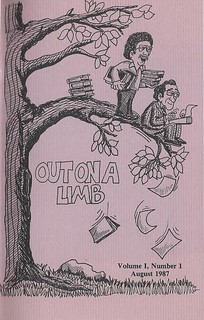 The advent of desktop publishing in the 1980s and subsequent rise of the Internet created publishing platforms accessible with a few keystrokes. Frequently the content did not justify even
that minimal effort, but in a few exceptional cases the ease of publication served to preserve voices that otherwise would have been lost. Out on a Limb is solidly in the latter category, and
Ken Lowe’s musing on all matters numismatic is now accessible on the Newman Portal.
The advent of desktop publishing in the 1980s and subsequent rise of the Internet created publishing platforms accessible with a few keystrokes. Frequently the content did not justify even
that minimal effort, but in a few exceptional cases the ease of publication served to preserve voices that otherwise would have been lost. Out on a Limb is solidly in the latter category, and
Ken Lowe’s musing on all matters numismatic is now accessible on the Newman Portal.
The house organ of The Money Tree from 1987 until Lowe’s untimely passing in 1998, Out on a Limb is a veritable stream of consciousness from a first-rate raconteur. Lowe’s comments on people and personalities illuminate the era in an amusing manner, and it is difficult to read a single page without breaking a smile. A few samples:
(September 1990) “I got to ride as the front seat passenger, and Dr. John M. Kleeberg of the ANS, Walter Breen, and John Burns had to sit in back. The rest shall be left to your imagination, but rest assured, your imagination is not exaggerating.”
(November 1993) “The K.M. Lowe Correspondence School Mini-course in Numismatic Library Perusal and Evaluation. Points are taken off for the following offenses: [1] Neatness (if it is neat, you ain’t usin’ it) [2] No books on floor (if you have room for all your books on the shelves, you don’t have enough books) [3] A tidy desk - keeping a tidy desk takes valuable time away from book stuff. If the desk in the library does not have catalogues, correspondence, and emerging life forms developing among the clutter, then you are not devoting enough time to your mania.”
(January 1998) “Editor’s note: the reader submitting the best answer to that question will win a one-year subscription to OUT ON A LIMB. The Second Place winner will win a two-year subscription.”
The impetus for Out on a Limb was a 1987 dinner party invitation from Mr. and Mrs. R. Henry Norweb, Sr. Lowe thought the event should be memorialized for posterity, and the gala is thoroughly documented in the inaugural issue. Lowe’s observations on the contrast between high society and the hoi polloi are liberally dispensed, and one senses that his pen would have been welcome at a Three Stooges scriptwriting session. There’s no pie throwing, but you get the idea. I was not fortunate enough to meet Ken, but I am sure everyone who did treasured his friendship and wit.
Thanks to Myron Xenos of the Money Tree for granting permission to scan Out on a Limb, and Joel Orosz for loaning a complete set of unbound issues.
That's Mryon standing behind Ken at the typewriter. I had the pleasure of knowing both Myron and Ken quite well, and spoke with Myron recently in getting his OK to host the Limb on the portal. I both bought and consigned material to many of their Money Tree sales and price lists. They were among the numismatic guests at my wedding nearly twenty years ago.
Ken's sudden passing was a shock, and I was among the numismatic attendees at his funeral. One regret I've always had is that Ken left us before the advent of The E-Sylum. While a different type of publication than Out on a Limb, The E-Sylum similarly offers a platform for musings on numismatic literature and the people who create and collect it.
As Len noted, Ken's great sense of humor is infused throughout the publication. Highly recommended reading for numismatic bibliophiles and curious collectors alike. -Editor
Link to Out on a Limb on the Newman Portal:
https://nnp.wustl.edu/library/publisherdetail/518985
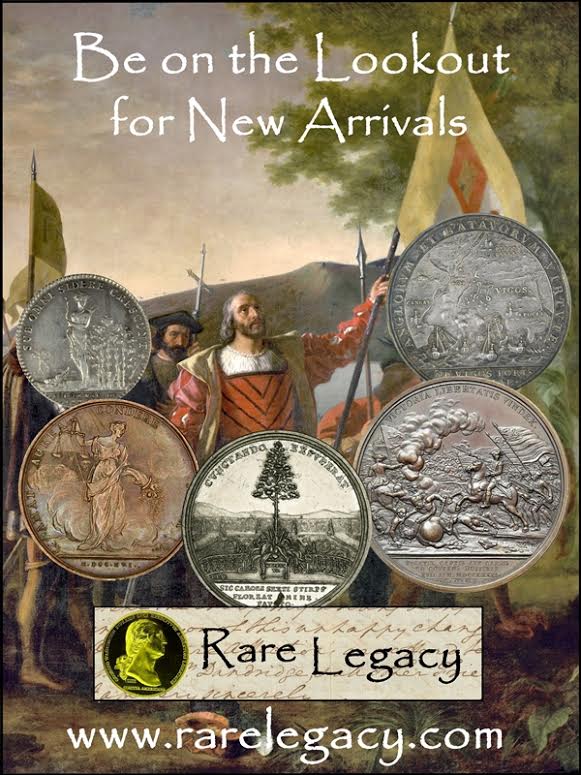
NOTES FROM E-SYLUM READERS: MAY 14, 2017
PAN Coin show Enthusiasm
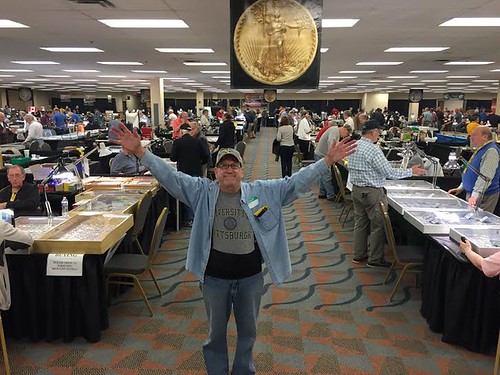
Pat McBride contributed this photo of longtime Pennsylvania Association of Numismatists member Chick Ambrass at this weekend's PAN Show near Pittsburgh. One of the Facebook comments: "We haven't seen this much coin show enthusiasm in Nebraska for 20 years."
On Discerning Meaning From Numismatic Information
In comments on April 16, 2017, I wrote:
Are we on the cusp of another sea change in the hobby? It's not just pricing data being made freely available. The internet has brought a large amount of non-price information out in the open, in the form of personal and club web sites, and the digitization of out-of-print numismatic books and periodicals by Google and others.
With the advent of the Newman Numismatic Portal, over a million pages of numismatic literature provided by its sponsor and partners are available in a single searchable index. This ready availability of information could help draw and retain the interest of new collectors and researchers, particularly among the younger generation.
Jeff Starck of Coin World writes:
While there is an abundance in volume of numismatic information now becoming available, mainly thanks to specialized authors and the Newman Numismatic Portal, there will still be value in the ability to navigate it, understand it, and discern meaningful information from it.
Because of the increasing information, the market will change, but then it has always been changing, and dealers and collectors have always had to adapt. Kudos to the scholars for doing the research, and for the Portal and NNEPS for sharing the information. The next few decades of numismatics will surely be richer for it.
To read the earlier E-Sylum article, see:
PRICE TRANSPARENCY AND THE $100 MILLION BARRIER (www.coinbooks.org/v20/esylum_v20n16a10.html)
"We Forgive You" Bicentennial Medal
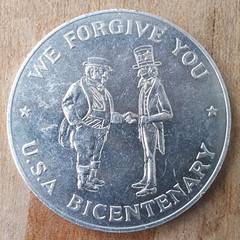
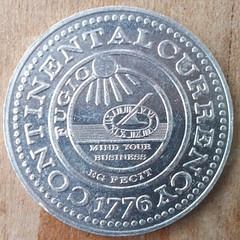
David Pickup writes:
Here's a medallion I bought yesterday for £3.00. Who is forgiving whom? Did it take 200 years to forgive each other?!
David adds:
At our meeting this week I showed it and someone said it was produced by Richard Lobel, a London coin dealer.
Medallic History of Religious Conflicts in Britain
Ben Weiss writes:
For more on Guy Fawkes and the Gunpowder Plot put into the historical perspective of the conflicts between Protestants and Catholics in 16th and 17th century England, see the article How a German Became King of England: Part I: A Medallic History of Religious Conflicts in Britain, as published by the Medal Collectors of America in the MCA Advisory.
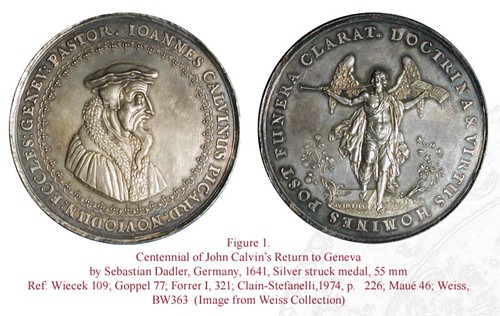
He was born in Hanover, Germany, and could hardly speak a word of English. So how in the world could George Louis, Elector of Hanover, become king of England?
To answer this question we must review briefly the role religion played in selecting the British monarchs, in particular how the competition between Catholics and Protestants shaped the history of Great Britain.
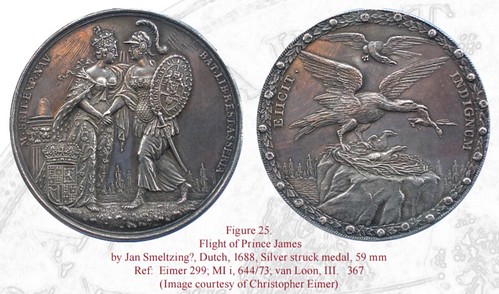
To read the complete article, see:
www.historicalartmedals.com/April%202015%20print%20edition.pdf
www.historicalartmedals.com/How%20a%20German%20Became%20King%20of%20England,%20Part%20II%20MCA.pdf
For more information on the Medal Collectors of America, see:
www.medalcollectors.org
On Numismatic Spelling and Punctuation
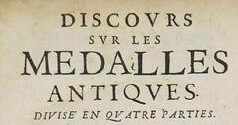
Regarding the 1627 book on medals mentioned last week, Ron Haller-Williams writes:
It might seem as though the cataloguer was in a hurry! Either that, or in need of new spectacles! The word "MÉDAILLES" might perhaps now be considered as spelled correctly, because:
(a) There is a convention that accents are not required on upper-case (capital) letters; on the other hand, we have accented capitals in DIVISE' and TRAICTE' - though this might be to avoid ambiguity?
![]() (b) In both occurrences on the title page, there is a small lower-case italic "i" between the "A" and the first "L". Of course, in those days (and at least up
to 1776), Roi, loi, etc. were spelled Roi, Loi, etc. - as with the last word on that title page.
(b) In both occurrences on the title page, there is a small lower-case italic "i" between the "A" and the first "L". Of course, in those days (and at least up
to 1776), Roi, loi, etc. were spelled Roi, Loi, etc. - as with the last word on that title page.
Or have they been inked in? They are indeed missing from these specimens
https://books.google.co.uk/books?id=Tb4WAAAAQAAJ&printsec=frontcover#v=onepage&q&f=false
https://books.google.co.uk/books?id=Tb4WAAAAQAAJ&printsec=frontcover#v=onepage&q&f=false
https://books.google.co.uk/books?id=goU--HSwuVkC&printsec=frontcover#v=onepage&q&f=false
Note: "Troisième" was spelt "Troisiesme", and "Quatrième" as "Quatriesme", likewise "plutôt" as "plustost" (p.316) - all with the "long s", of courfe! And one really has to think about e.g. "Que le denier d'argent a esté d'ordinaire de sept & de huict en l'once".
There are also about 30 occurrences of "medalle" or "Medalle" inside the book – no excuse for omitting the accent on these! And, of course, this is before the Académie française was established (1635), the letters patent registered on 10 July 1637 "to labour with all the care and diligence possible, to give exact rules to our language", and its starting to publish a dictionary in 1687.
Interestingly, a dictionary of 1673 gives both Medaille AND Medalle as an alternative to it! (but NOT Médaille) -
https://books.google.co.uk/books?id=ISi4M196tl4C&q=medalle
Mind you, I believe Chaucer used three different spellings for the word "penny"!
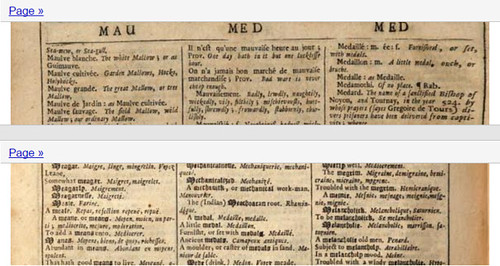
To read the earlier E-Sylum article, see:
NUMISMATIC NUGGETS: MAY 7, 2017 : 1627 Book: Discours sur les médalles antiques (www.coinbooks.org/v20/esylum_v20n19a20.html)
On the Waterloo Medal Dies
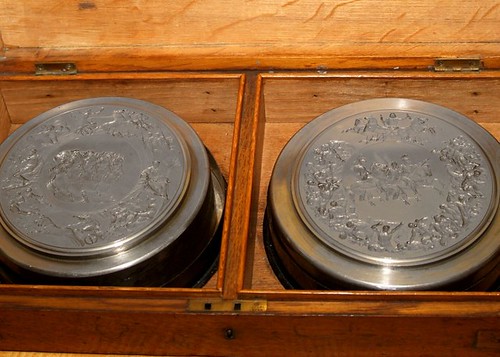
Dick Johnson writes:
Pistrucci’s Waterloo Medal dies could never have struck the medal. The Royal Mint’s decision not to attempt to strike even one medal was absolutely correct. The dies would have broken with the first blow. Was this Pistrucci’s little joke on the Mint knowing it could never strike a medal that size? After all, he was a savvy medallist with the knowledge of what die’s requirements were necessary.
The diestock was not the required diameter. The die lacked mass. It needed more mass to withstand the pressure of even one blow. Also it would require several blows, the number depending upon the type of metal of the blank and its hardness, making it even more vulnerable.
The Mint’s decision to make electrotypes was also correct. It could have made electrotypes in any typical medallic composition, gold, silver, or copper. The technology for electrotyping in England was not available until after 1840. A German physicist, John Wright, developed the electrolysis process in 1837. The British Elkingtons (cousins George and Henry) patented electroplating in 1840 using that process.
So the Royal Mint thwarted Pistrucci’s little joke in the end by making the medal after all.
To read the earlier E-Sylum article, see:
FEATURED WEB PAGE: THE WATERLOO MEDAL DIES (www.coinbooks.org/v20/esylum_v20n19a35.html)
Louisiana Purchase Sesquicentennial Medals
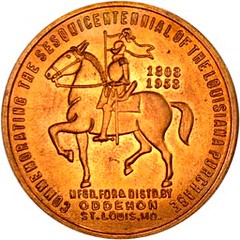
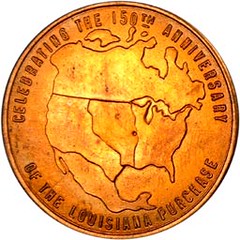
Regarding the failed attempt to authorize an official commemorative half dollar for the 150th anniversary of the Louisiana Purchase, Jeff Starck of Coin World writes:
Though there was no coin for the 150th anniversary of the Louisiana Purchase, St. Louis dealer Otto Odenhon issued his own medal, which is cataloged as a So-Called Dollar (Hibler & Kappen-509).
Coin World columnist David T. Alexander wrote about this not that long ago.
To read the Coin World article, see:
What links St. Louis numismatist Otto Oddehorn to the Louisiana Purchase?
(http://www.coinworld.com/news/us-coins/2016/09/saint-louis-coin-dealer-issues-exposition-medal.all.html)
For more information on the issue, see:
LOUISIANA PURCHASE SESQUICENTENNIAL 1953 ST. LOUIS, MO
(http://www.so-calleddollars.com/Events/LA_Purchase_Sesquicentennial.html)
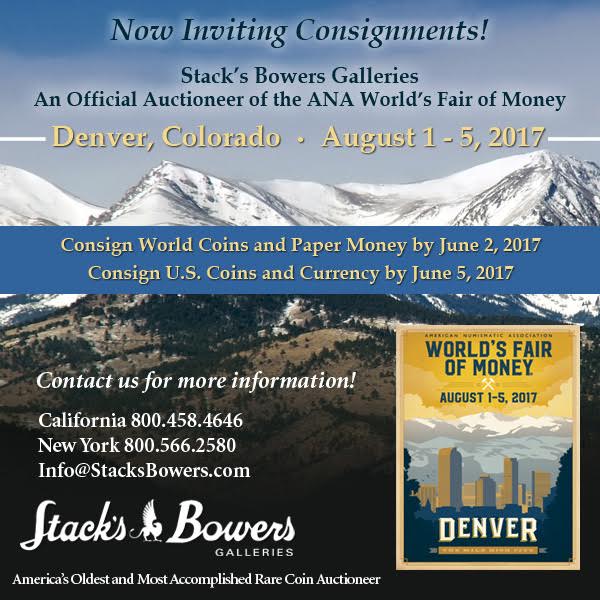
EARLY AMERICAN CALENDAR MEDALS

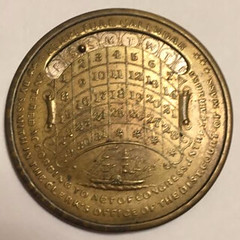
Grant Calendar Medal
Duane Feisel avers that [American] calendar medals, in his lengthy experience, first originated during the 1892-93 Worlds Fair Columbian Exposition.
Actually, American calendar medals date back , in my experience, to 1855 (non-mechanical) and 1857 to 1859 (mechanical, protruding metallic nub moves days of the week) with foreign calendar medals going back centuries earlier. But let's just address American mechanical calendar medals as that is what Feisel addresses.
First, there is the pictorial George Washington mechanical calendar medals of 1857-59 by Benjamin C. True, Cinn. diesinker & 1858 by Peter J. Jacobus Phila. diesinker, Baker #'s 385 thru 387, the latter calendar medal rather common, the former moderately scarce. In choice condition - they range around $125.
But in a much higher price range & considerably rarer than your mass-produced & common Worlds Fair Columbian Expo (and later) mechanical calendar medals, there is the 1860 Campaign ferrotype (mini-tintype) versions of a clean shaven Abraham Lincoln (Captain Andrew C. Zabriskie coll'n, Sotheby's 6 /1999 lot 530- catalogue cover plate image ) at an astonishing & unsurpassed $38,500, 18 years ago!
Into the Civil War and post-War political campaigns, Col. Elmer Ellsworth the 1st Union officer killed by a Confederate soldier in 1861 ferrotype mechanical calendar medal. And 1868 Presidential Campaign & victor "jugate" Gen'l U.S. Grant with VP Stephen Colfax ( JJ Ford, Jr Stack's 9 /2013 lot 12163 ) at $5,581 and Grant alone ( Ford, lot 12164 ) at $2,585. There is also reported a ferrotype calendar medal version of Major Robert Anderson Fort Sumter commanding officer. Both the Ellsworth and Anderson ferrotype mechanical calendar medals would be worth each solid four figures.
On all these ferrotype mechanical calendar medals, you can count each known population on the fingers of one hand and they are tightly- held. Rarer than your 1804 $, 1913 5c or 1894-S 10c. And a lot more affordable, yet more challenging to acquire. Not to speak of that many of those extant are not perfect condition.
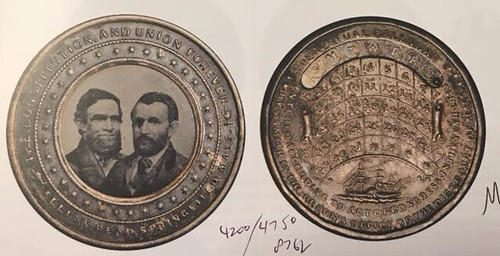
Grant-Colfax Calendar Medal
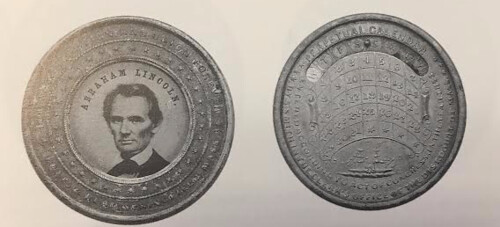
Abraham Lincoln Calendar Medal
Hemerologe Medals
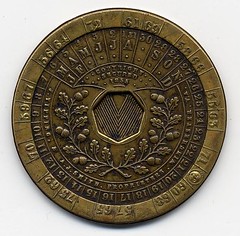

I have seen the discussion of perpetual calendars and thought I would chime in about one that is somewhat local to us in the D.C. region. In my collection, I have a brass "Hemerologe" made by James Tipping in Winchester, VA in the 1850s. It is made in two pieces and is supposed to be able to give the date "in all perpetuity."
The two storecards are interesting: they are made in two pieces with one inside the other almost like a shellcard. The letter punches for both storecards appear to have also been used to make the hemerologe. Not only that, both shellcards have different addresses even though they are for the same merchant.

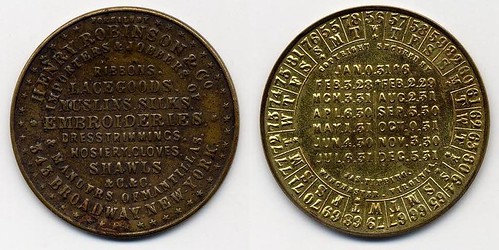
Back in 2011, I wrote a brief article in The Virginia Numismatist about it and included some images of a broadside advertising the hemerologe. Here's what I wrote:
In the mid to late 19th century, pocket calendars were a popular item and many tokens from the 1870s advertise several such calendars. One such calendar was produced and marketed by James Tipping of Winchester, Virginia. James Tipping was born in Ireland around 1818 and eventually became a retailer in crockery and dry goods whose store was located on Loudoun St. between Piccadilly and Water (Boscawen) Sts. He also partnered with A. J. Smith to help produce the “Hemerologe, or Medallic calendar, for current use to all futurity, as well as for reference to any date in the Nineteenth Century designed for the pocket”.
The hemerologe is a 45 mm diameter two piece dial calendar which allowed the user to see which day of the week falls when for any date up to 1900. There appear to have been two different versions of the hemerologe: one which was illustrated in an 1854 broadside and a revised version that was produced in 1855. Tipping also entered a copyright on April 10, 1857 for a “lunar hemerologe”, and is currently known through a notation in the 1856-1857 Accession Record of the Smithsonian Institution. Tipping’s Hemerologe was evidently marketed and retailed by Henry Robinson & Co., Broadway, New York.
Robinson issued two different store cards (with different street addresses) made in two pieces of thin brass 38 mm in diameter, with the calendar side set inside the larger advertising side. The hemerologe and both store cards share the same letter punches as well as overall style, thus were presumably made by the same maker, which may have been Tipping and Smith themselves, as Winchester had a flourishing copper and silver smith industry at the time.
To read the earlier E-Sylum articles, see:
VOCABULARY TERM: CALENDAR MEDAL (www.coinbooks.org/v20/esylum_v20n17a16.html)
NOTES FROM E-SYLUM READERS: APRIL 30, 2017 : More on the Perpetual Calendar Medal (www.coinbooks.org/v20/esylum_v20n18a09.html)
NOTES FROM E-SYLUM READERS: MAY 7, 2017 : More on Calendar Medals (www.coinbooks.org/v20/esylum_v20n19a08.html)

VOCABULARY TERM: DOUBLE STRUCK
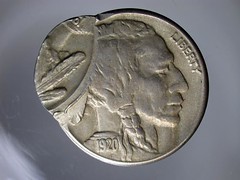
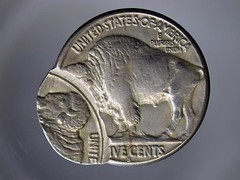
Double Struck has two meanings. Shown here are double struck errors which are unintended anomalies. It can occur in coining any denomination; the second blow may cover a small or large portion of the original strike. Photos Fred Weinberg.
Double Struck. Literally struck twice; an intentional double blow, as in a coining press designed to deliver two cycles of the press before the struck piece is ejected. The purpose of double striking is to provide a sharper, better strike with greater assurance that every cavity of the die is filled, the edge is complete and the RIM/EDGE JUNCTURE is as perfect as possible. Some proof surface pieces, coins or medals, are often double struck to provide the higher quality piece that could not be done with production run coinage and production run dies. See MULTIPLE STRIKING.
One might think if double struck is better than single struck, then why not three (or more) blows? The answer is that with each striking the piece becomes work hardened; a third (or more) blow would not move any more metal to fill the entire cavities of the dies. Production run coining must accomplish this in one blow. Proof coins and medal striking can afford the luxury of a second blow.
Double struck anomalies. Most double struck anomalies are from an unintentional second blow. Often there is some movement of the blank so the second blow is not exactly in the same position as the first. Thus the second image is superimposed on the first, but some evidence of the first image still exists.
Double struck can also be from a roller die on the edge of a numismatic piece; from a punch or logotype struck twice; or counterstamp with two images from the same letters or punches. In a sense, double struck may explain any act of impression which is performed twice.
Reference: NE42 {1982} Doty, p 110-111.
CLASS 06.5
Looking for the meaning of a numismatic word, or the description of a term? Try the Newman Numismatic Portal's Numismatic Dictionary at: https://nnp.wustl.edu/library/dictionary
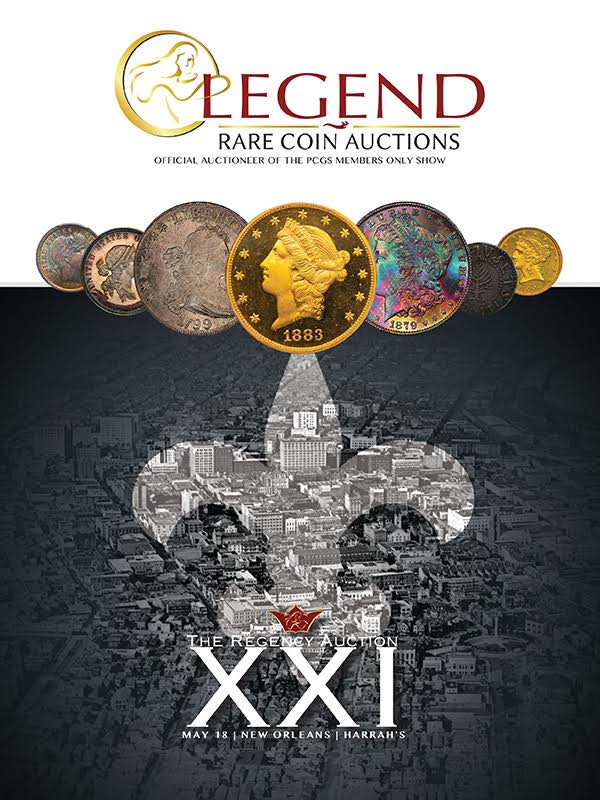
WALTER B. GOULD (1848-1932)
 Walter B. Gould (1848-1932), was born at East Corinth, Penobscot County, Maine, on February 29, 1848, son of Robinson Gould (1820-1872), a butcher at Bangor, Maine, and Elizabeth J. Huse
Gould (1818-1904).
Walter B. Gould (1848-1932), was born at East Corinth, Penobscot County, Maine, on February 29, 1848, son of Robinson Gould (1820-1872), a butcher at Bangor, Maine, and Elizabeth J. Huse
Gould (1818-1904).
Walter B. Gould was a merchant lifelong and in retirement became a coin and stamp dealer. He is best known for his pioneering research on counterstamped Large Cents from 1914 to 1921.
In 1871, he was married Nellie A. Gould (1847-), a native of Maine. They had a son named Edgar W. Gould (1874-1921). In 1871 he was a confectionary dealer with the firm of Messrs. Boyd at Bangor, Maine. In 1872, he opened a confectionary store Walter B. Gould & Co., Bangor, Maine. In 1880, he was a fruit dealer who also sold tobacco.

Walter B. Gould's U. S. Copper Cents collection 1793 - 1856 numbered 20,000 specimens and was stored in a 6 peck sized glass jar. The news report was published throughout the country the entire year with dates of the oldest Cent ranging from 1703 to 1796 from reporters who were obviously not collectors.
On October 21, 1908, he married Rebecca F. Moody (1843-), of Everett, Massachusetts, at Bangor, Maine.
In the U. S. Census 1910 he was a widower living in Aroostook, Presque Isle, Maine with his brother Arthur Gould and sister-in-law Mary Frances Gould. He was a lumberman who owned a sawmill.
In 1911, he married his third wife Mertie E. Hartley (1869-), of Maynard, Massachusetts, daughter of James L. Phillips and Frances L. Littlefiled, on February 23rd at the Methodist Church, Portsmouth, New Hampshire.
In 1913, he lived in Winterport, Maine, and applied for membership in the A. N. A. In April 1913, he was assigned A.N.Member No. 1677. In 1913, he began to trade as a coin and stamp dealer.
In the July 1917 issue of The Numismatist, on page 306, "Numismatists Aid the Red Cross," Walter B. Gould raised funds for the Red Cross by donating 5,000 old U. S. Copper Cents placing them in drug stores to be sold for 10 cents apiece. At his labor and expense all mailing and collections were made giving the entire proceeds to the Red Cross Society.
Gould sent in to the May 1914 issue of Collector's Blue Book, a report that he had two bushels of Large Cents of which eighty had countermarked names. In the August 1921 issue of The Numismatist, on pages 331-332, and page 378 in September, in Frank Duffield's, "A Trial List of the Countermarked Coins of the World," he contributed to the article on countermarked coins with stencil dies cut for Ben Parker with his counterstamp B. Parker. Also J. W. Strange, and his son C. A. Strange, and Thomas J. Stewart as T.J.S., in a large group of personal names stamped on coppers in the Gould collection.
Gould knew Ben Parker and J. W. Strange when he was a boy. They were both metalworkers and brass founders. Russ Rulau wrote about them in his book, U. S. Trade Tokens 1866-1889 (Iola : Krause, 1988). These were later on written about by Dr. Gregory G. Brunk in the February 1989 issue of The Numismatist. Later Brunk published his classic work Merchant and Privately Countermarked Coins.
He and his wife attended the 1921 A.N.A. Convention and are in the official photograph.
 [Here is his] advertisement selling lot of 51 Large Cents with original Mint luster for $16.00. Set of bound volumes of American Journal of Numismatics 1874-1879 for only $10. A
large lot of 42 bound coin coin books + pamphlets, catalogues and fixed price lists valued in 1926 at $100 selling at close out price for $25. George, David, and Charles there are still deals out
there!
[Here is his] advertisement selling lot of 51 Large Cents with original Mint luster for $16.00. Set of bound volumes of American Journal of Numismatics 1874-1879 for only $10. A
large lot of 42 bound coin coin books + pamphlets, catalogues and fixed price lists valued in 1926 at $100 selling at close out price for $25. George, David, and Charles there are still deals out
there!
He died on July 26, 1932. He is buried at Mount Hope Cemetery, Bangor, Penobscot County, Maine. His Diaries are in the Bangor Public Library.
To read the complete article, see:
GOULD, WALTER B.
(https://sites.google.com/a/numismaticmall.com/www/numismaticmall-com/gould-walter-b)

PRINCETON ACQUIRES BYZANTINE COIN COLLECTION
The Princeton University Numismatic Collection announces the acquisition of Peter Donald’s vast collection of rare Byzantine coins. Comprising 5,280 coins, the London-based numismatic scholar’s collection is one of the most comprehensive private collections in the world. It provides an in-depth representation of virtually all known varieties of Byzantine bronze and silver issues from all eras and mints. The acquisition of this collection constitutes the central component of a decade-long program of building Princeton University’s numismatic holdings (long centered primarily on classical antiquity) into the premier collection in the world illustrating the interrelations of coinage systems of the medieval Eastern Mediterranean.
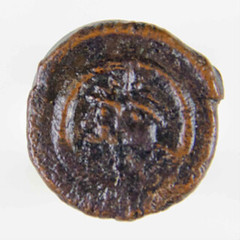
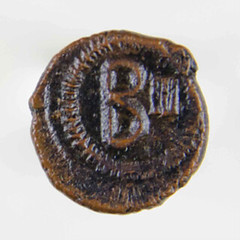
Bronze 2-nummus piece of the Heraclian Revolt, 610
The Peter Donald Collection of Byzantine Coins includes 179 gold coins, 324 silver coins, and 4,777 bronze coins ranging from 500 to 1450 C.E. It is complete as assembled over the past seven decades with the exception of gold issues before 1204, which the collector sold off by auction in 1995. Peter Donald is a well-known English scholar of Byzantine coinage, a Fellow of the Royal Numismatic Society and author of many articles based on his collection. He is co-author with Simon Bendall of the standard work on late Byzantine coinage, The Later Palaeologan Coinage, 1282-1453 (London, 1979).
Mr. Donald, who served in the Royal Navy during the Second World War and worked from 1947 to his retirement in 1980 for the Port of London Authority, began collecting Byzantine coins in 1952, following a chance encounter with a cup-shaped copper coin in the shop of a London antiquary. During the past 65 years, he worked to make his collection remarkably inclusive, including rare mints and short-lived rulers, and consistently upgraded pieces.
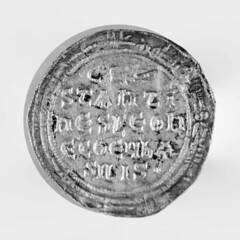
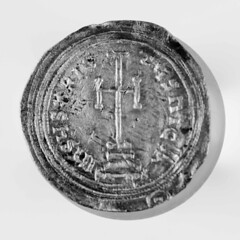
Silver miliaresion, Leo IV, 741-745, overstruck on an Ummayad dirhem
Several outstanding pieces illustrate the collection’s importance. Mr. Donald’s own favorite coin is a unique two-nummus bronze coin of Heraclius, the Exarch of Alexandria, with his son the future emperor of the same name, believed to have been minted on Cyprus in 610 during their revolt against the emperor Phocas; the Donald specimen is the discovery coin for this issue and is believed to be unique. Silver is rare in the Byzantine series, but the eighth century issues of the miliaresion appear to have achieved popular acceptance, perhaps because they were modelled on Islamic dirhems, which dominated the coinage of the Near East.
A miliaresion of Leo IV (741-775) in the Donald Collection is clearly overstruck on a dirhem, probably an issue of the Wasit mint from the 102s AH (737-748 CE). A gold hyperpyron from the reign of John V (1341-91), shows the emperor’s late father Andronicus III kneeling before Christ on the obverse, with the young John and his mother, the regent Anna of Savoy, standing on the reverse. Of the seven examples of this extremely rare issue in the Donald Collection, one is of special importance for its provenance: it was part of the 1922 sale of the émigré Russian prince Mikhail Cantacuzene, from a collection formed in the XV11 century by his ancestors, themselves descendants of Byzantine emperors.
Princeton University is increasingly being recognized as the leading American teaching institution for Byzantine Studies, with three faculty members of the History Department, one in Art and Archaeology, one in Classics, one in Music, and one in Philosophy teaching the field. Princeton University faculty enthusiastically supported the acquisition of the Donald Collection. Historian Peter Brown calls it “a magnificent and very comprehensive collection, of huge interest to scholars, even outside the Byzantine field.”

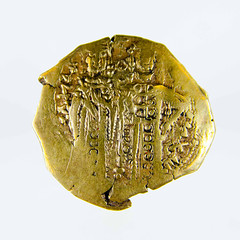
Gold hyperpyron, John V, 1341-47
John Haldon, Professor of History and Hellenic Studies, highlights “the way in which this collection will enhance our research and teaching potential. With this acquisition we jump into first place in respect of the teaching, study and research of Byzantine and medieval coinages in the Americas.” It follows the acquisition of the Latin Orient Collection in 2008, the Armenian Heritage Collection in 2010, the Redford Collection of Turcoman coinage in 2011, the Undeland Collection of Mamluk coinage in 2013, and the Schaaf Collection of Sasanian Coinage in 2015.
To read the complete press release, see:
New Acquisition: The Peter Donald Collection of Byzantine Coins
(http://library.princeton.edu/news/rare-books/2017-05-10/new-acquisition-peter-donald-collection-byzantine-coins)
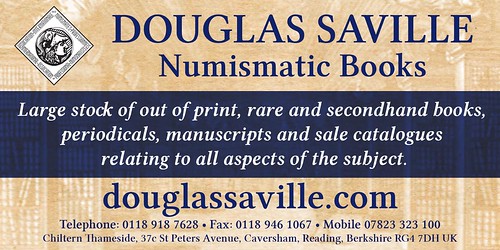
DAHLONEGA MINT GOLD COIN SET EXHIBIT
 A complete 62-coin set of gold coins struck at the Dahlonega Mint that was assembled for the express purpose of one day being donated and put on public display will go on exhibit June 5 at
the University of Georgia in Athens.
A complete 62-coin set of gold coins struck at the Dahlonega Mint that was assembled for the express purpose of one day being donated and put on public display will go on exhibit June 5 at
the University of Georgia in Athens.
The collection of Dahlonega Mint gold coins is a major component of an extensive multi-gallery presentation on the history of gold and gold mining in Georgia, the production of gold coins in the Branch Mint of the United States at Dahlonega, and the evolution of currency in America, including paper money, with a focus on Georgia.
Katherine Stein, director of the university’s Hargrett Rare Book and Manuscript Library, said the exhibit will be staged in the Russell Building Special Collections Libraries at the university.
Stein said the exhibit — titled “Gold-digging in Georgia: America’s First Gold Rush,” — is based on the article “From Georgia to California and Back: The Rise, Fall, and Rebirth of Southern Gold Mining” by Dr. Drew Swanson, published in a 2016 issue of Georgia Historical Quarterly, published by the Georgia Historical Society.
 Collector John McMullan took less than 10 years to assemble the collection of Dahlonega Mint gold coins, which were produced at the facility between 1838 and 1861.
Collector John McMullan took less than 10 years to assemble the collection of Dahlonega Mint gold coins, which were produced at the facility between 1838 and 1861.
The 81-year-old McMullan dubbed his assemblage The Reed Creek Collection after the region of Georgia in which his father, Thomas Leverette McMullan, was born and raised.
Only gold coins were ever struck at the Dahlonega Mint, in $1, $2.50, $3, and $5 denominations.
McMullan said he began assembling The Reed Creek Collection as a tribute to his father with the Aug. 5, 2008, purchase of the first coin, the 1854-D Indian Head $3 coin.
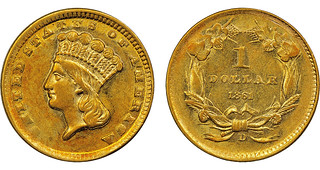 McMullan’s father graduated circa 1919 or 1920 from the University of Georgia and upon graduation, took a job teaching agriculture in North Georgia College.
McMullan’s father graduated circa 1919 or 1920 from the University of Georgia and upon graduation, took a job teaching agriculture in North Georgia College.
The former Dahlonega Mint building was used by the college from 1873 until it burned in 1878. A new building used by the college was subsequently erected on the foundation of the former Branch Mint structure.
For more information on the exhibit, see:
Gold-digging in Georgia: America’s First Gold Rush (www.libs.uga.edu/news/gold)
To read the complete article, see:
62-coin Reed Creek Collection prominent in June 5 to Dec. 5 exhibit
(www.coinworld.com/news/us-coins/2017/05/collector-donates-dahlonega-gold-coins-for-exhibit.all.html#)
THE BOOK BAZARRE
Redbooks!1947 to 2016, (missing 1969)
with 18 Special Editions – one
Bressett signature, retail approx. $2600-$2900.
Call Paul Cunningham 517-902-7072.
GOLDBERGS OFFER ECKFELDT FAMILY MATERIAL
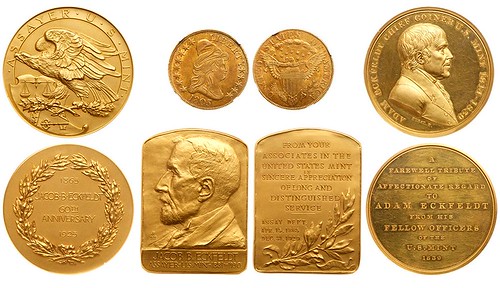
Eckfeldt Collection, First Family of the U.S. Mint, Including Likely-Unique Mint Medals, an 1803 $10 MS61, and Mint-related Presidential Documents. The collection encompasses historic gold medals and documents that belonged to the Eckfeldt family, whose history with the U.S. Mint goes back to the 1790s, when John Jacob Eckfeldt was a contractor to both the Mint of North America and the first U.S. Mint. The Eckfeldts were involved in creating coinage for the colonies, even before they won their independence. Highlights of the collection include:
1. An 1839 gold medal presented to Adam Eckfeldt upon the occasion of his retirement from the U.S. Mint. The solid gold (likely 900 fine) medal depicts Adam Eckfeldt as Chief Coiner of the Mint from 1814-1839. It is 50mm in diameter and weighs 104.1 grams. This gold striking is believed to be unique. It is graded PF62 by NGC. 2. The
1925 gold medal presented to Jacob B. Eckfeldt upon his 60th anniversary as an employee of the Mint. This medal is gold (likely 900 fine), 50 mm and weighs 76.19 grams. Graded PF66 by NGC and likely unique.
3. The 1930 U.S. Mint medal given to Jacob B. Eckfeldt upon his retirement in 1930. Engraved on the obverse is: "Assayer-U.S. Mint 1881-1930" and on the reverse: "From your associates in the U.S. Mint in sincere appreciation of long and distinguished service. Assayer Dept. April 15 1865 Dec 31 1929." The medal is 55 mm in length, 40 mm in width, and weighs 91.16. Also likely unique.
4. The 1803 $10 gold eagle, graded MS61 by NGC, was obtained by a family member in 1807. It is accompanied by the original envelope and letters documenting its provenance from that time.
5, Three original presidential appointments, including:
(A) Document signed by James Madison as President and by James Monroe as Secretary of State, appointing Adam Eckfeldt as Chief Coiner of the U.S. Mint, Feb. 15, 1814.
(B) Document signed by Andrew Jackson as President and Edward Livingston as Secretary of State, appointing Jacob R. Eckfeldt Assayer of the U.S. Mint, April 30, 1832.
(C.) Document signed by Chester A. Arthur as President and Frederick T. Frelinghuysen as Acting Secretary of State, Dec. 21, 1881.
John Adam Eckfeldt (1769-1852, known as Adam) served as the second chief coiner of the Mint, from 1814 until 1839. His father, John Jacob Eckfeldt, was a German immigrant who owned a large smithy and was involved in early attempts at American coinage; he made dies for Robert Morris's coinage in 1783. Adam Eckfeldt built early presses for the Mint, engraved some of its early dies, and was responsible for the designs of early American copper coinage, as well as the 1792 half disme, which some authorities consider the first United States coin. He was appointed assistant coiner of the Mint in 1796, and became chief coiner on his predecessor's death in 1814. When Adam Eckfeldt retired in 1839, after 47 years, the other officers of the Mint had a gold coin struck as a token of their respect for him. Bronze copies were struck for the other officers and two were struck in silver and were given to the President and the Secretary of the Treasury.
Jacob R. Eckfeldt (1803-1872), Adam's son, was appointed Assayer of the Mint in 1821 and served in that capacity for 40 years. His son, Jacob B. Eckfeldt (1846-1938) served in the Mint from 1865 to 1929, 48 of these 64 years as Chief Assayer of the U.S. Mint. With the resignation of Jacob B., the Eckfeldt family ended 137 years of service to the U.S. Mint.
Also included in the collection are numerous historical letters related to the Eckfeldt family and the U.S. Mint, as well as some personal letters and photographs. This collection should definitely be examined personally to be appreciated. The historical and numismatic importance of this lot simply cannot be overstated. The Eckfeldt family was one of the dominate families that navigated the exhuasting politics from the highest levels of government and maintened their iron grip on the Philadelphia Mint itself for generations. The Eckfeldt family stewardship of this beloved institution places them at the pinnacle of decisions for the Mint, right down to the floor sweepings. An absolute treasure trove of information, historical documents and several juicy tidbits no doubt lie within the letters themselves (PCGS # 1056) Estimate Value $100,000 - UP
Alan V. Weinberg writes:
This group has been on the numismatic bourse market for over two years, exhibited for sale at both the Whitman Baltimore shows and the Long Beach Expo shows. It has been on consignment by Eckfeldt descendants family, and the asking price of $250,000 seems to have been set by the consignors, not the dealership. The collection elements have been available for in-hand examination at the shows.
The three US Mint medals are certainly at least .900 fine and Anthony Terranova's research indicates many older, virtually unique presentation US Mint gold medals are closer to .999 purity.
The unique gold 1839 Adam Eckfeldt gold medal is numismatically the most desirable of the group and is probably worth $60- $75,000 alone. Silvers are very rare and valued above $5,000 some years ago (one is in David Sundman's collection, ex Terranova and was on exhibit at a Baltimore show a few years back) and bronzes are also elusive.
The Goldberg firm's starting bid on the group is $50,000 (plus buyer's fee) and it should be worth at least double that hammer, assuming there is not a family-imposed reserve. If acquired, the 1803 eagle will almost certainly go its separate way. Aside from that 1803 eagle, the most valuable item is the Eckfeldt 1839 medal with the later Eckfeldt gold medals trailing in value at a great distance.


Pete Smith writes:
The Adam Eckfeldt retirement medal in gold was presented to Adam in 1839. When he died in 1852, his estate was divided among six living children and one grandchild. Each of them received a group of medals. The gold medal went to Jacob Reese Eckfeldt and was valued at the time at $70. Other descendents received silver medals and some of them remain with family members in 2017.
Jacob Reese Eckfeldt (1803-1872) probably left the Adam Eckfeldt gold medal to his oldest son, Adam Penn Eckfeldt (1837-1893). He had no children so the medal went to his oldest surviving brother, Jacob Bausch Eckfeldt (1846-1938). He added two more gold medals in 1925 and 1930.
His estate went to his oldest son, Howard Eckfeldt (1873-1948). From there it went to his oldest son, Jacob Trouselle Eckfeldt (1899-1967). Then it passed to Henry Eckfedlt who was born in 1938 and, as far as I know, is still living.
I made various attempts to locate the Adam Eckfeldt gold medal. Other family members guessed it was with Henry and I corresponded with him but he did not tell me he had the medal.
The three gold Eckfeldt medals and the Eckfeldt Family Archive came to light in 2014. The three medals were graded by NGC and exhibited at the ANA Convention that year in Chicago.
The entire archive was put up for auction on eBay with a closing date of November 9, 2014. The lot had an opening bid of $601,000 but failed to meet the reserve.
The collection was handled by Silvano DiGenova with Tangible Investments LLC of California. The collection was shown to some potential buyers but failed to sell and was returned to the family.
I learned at the Central States convention that the collection was coming up for sale again in 2017. I spoke to DiGenova about this at Central States but he was not aware of the upcoming sale.
It is a fabulous collection of material related to the family and the earlier days at the Mint. I would love to own any of the gold medals individually or the collection as a whole.
To read the complete article, see:
Eckfeldt Collection, First Family of the U.S. Mint, Including Likely-Unique Mint Medals, an 1803 $10 MS61, and
Mint-related Pres (www.goldbergcoins.com/view-auctions/catalog/id/56/lot/119064/)
THE BOOK BAZARRE
NUMISMATIC NUGGETS: MAY 14, 2017
Clay Moulds for a Wu Zhu Coin
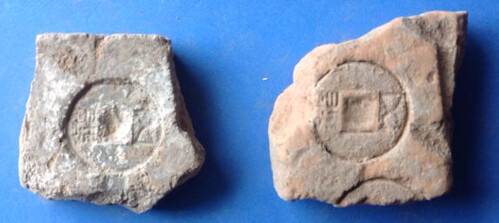
Lot consisting of two clay moulds for a Wu Zhu AE coin. The clay moulds were meant for casting a Wu Zhu coin, H.10.16, a coin from the Eastern Han dynasty, 25-250 A.D. The moulds are guaranteed to be authentic.
To read the complete lot description, see:
China – West Han Two clay moulds for a Wu Zhu coin (H.10.16)
(https://auction.catawiki.com/kavels/11519661-china-west-han-two-clay-moulds-for-a-wu-zhu-coin-h-10-16)
1987 Australia Nugget Bullion Coin

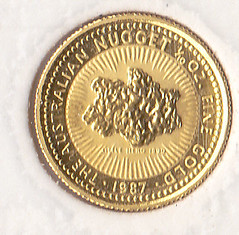
Australia – 15 Dollars 1987 Nugget – gold
To read the complete lot description, see:
Australia – 15 Dollars 1987 'Nugget' – 1/10oz gold
(https://auction.catawiki.com/kavels/11674271-australia-15-dollars-1987-nugget-1-10oz-gold)

WAYNE'S NUMISMATIC DIARY: MAY 14, 2017
Tuesday May 9, 2017 I left work and headed over to Alexandria for the monthly dinner meeting of my northern Virginia numismatic social group Nummis Nova. Aaron Packard was our host at Southside 815, a cozy bar and restaurant on South Washington Street (guess the address).
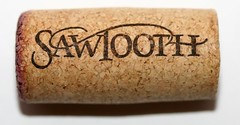 I was the first to arrive but had only just gotten settled in my chair when Dave Schenkman, Gene Brandenburg and Eric Schena walked in. I'd been debating whether to have beer or wine
with my Red Beans and Rice, but Gene helped me decide. We agreed that we couldn't resist ordering the wine from, of all places, Idaho. The Sawtooth Estate Winery product was so good we got a
second bottle.
I was the first to arrive but had only just gotten settled in my chair when Dave Schenkman, Gene Brandenburg and Eric Schena walked in. I'd been debating whether to have beer or wine
with my Red Beans and Rice, but Gene helped me decide. We agreed that we couldn't resist ordering the wine from, of all places, Idaho. The Sawtooth Estate Winery product was so good we got a
second bottle.
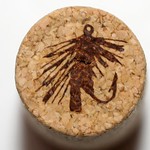 Idaho being a great place for fishing, check out the decoration on the cork, which was a great foil for puns. Gene said the wine had "a certain allure".
Idaho being a great place for fishing, check out the decoration on the cork, which was a great foil for puns. Gene said the wine had "a certain allure".
For more information on Sawtooth Estate Winery, see:
http://sawtoothwinery.com/
Tom Kays sat next to me. See below for his writeup. I spoke with our host Aaron Packard for a bit. Unfortunately, he had to catch a train to New York for a business meeting and couldn't stay for the whole evening.
Here are some of the numismatic items being passed around.
Young America Furnace Company Notes
Dave Schenkman passed around an interesting group of three rare obsolete notes. He writes:
Located at Petrea, Ohio, the Young America Furnace Company was only in business for a few years, circa 1856-1860. These rare notes surfaced on eBay recently. Wendell Wolka lists the fifty cents and one dollar denominations in A History of Nineteenth Century Ohio Obsolete Bank Notes and Scrip; the three dollar is unlisted. Unfortunately, they have been glued at the top of each note to a sheet of paper. I’d appreciate suggestions on the best way to remove them from the paper.
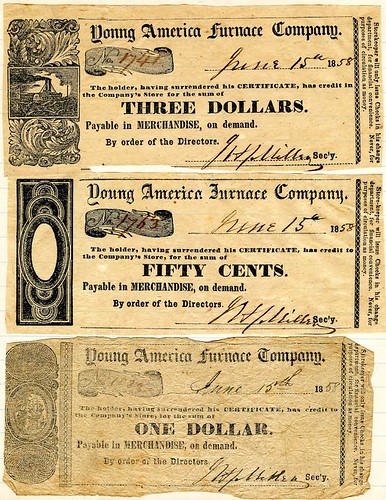
Eric Schena suggested finding a paper/book conservator who may have the proper archival treatments to remove the adhesive. Would anyone have other suggestions for safely separating these notes from the paper? They are only affixed by a small strip at the top.
Latvian Banknotes
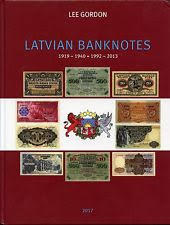 My only display item was a copy of Lee Gordon's new book on Latvian Banknotes. An obscure subject to be sure, but we were all impressed by the quality of production and the great
color photos of many beautiful banknotes. Thanks to Lee for providing these images.
My only display item was a copy of Lee Gordon's new book on Latvian Banknotes. An obscure subject to be sure, but we were all impressed by the quality of production and the great
color photos of many beautiful banknotes. Thanks to Lee for providing these images.

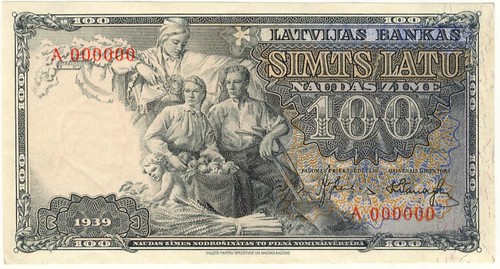
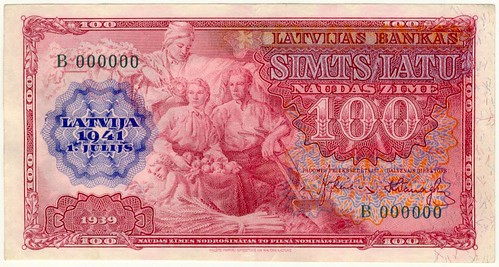
Refering to the third note, Lee proudly adds:
There are only three 100 Latu 1939 Series B notes known in the World. I have two of them!
To read the earlier E-Sylum article, see:
NEW BOOK: LATVIAN BANKNOTES (www.coinbooks.org/v20/esylum_v20n18a03.html)
Photo Gallery
Here are some of the photos I took of the event. First, a group shot from my end of the table. Clockwise from left: Eric Schena, Steve Bishop, Roger Burdette (behind Steve), Dave Schenkman; Far end:
Julian Leidman; then Mike Packard, Lenny Goldberg and Tom Kays, reviewing a copy of Roger's new book on U.S. Proof coins.
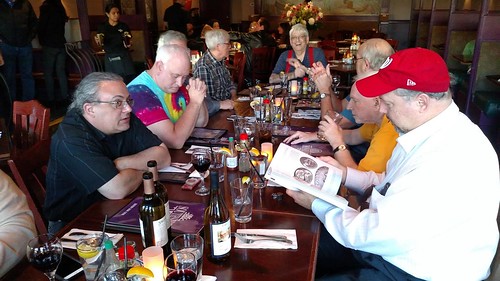
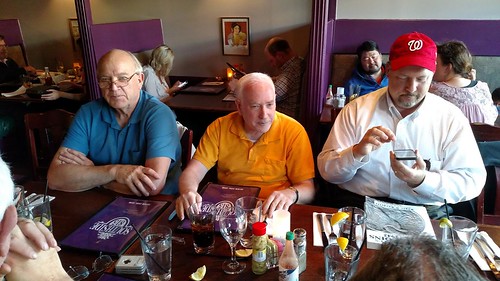
Mike Packard, Lenny Goldberg and Tom Kays
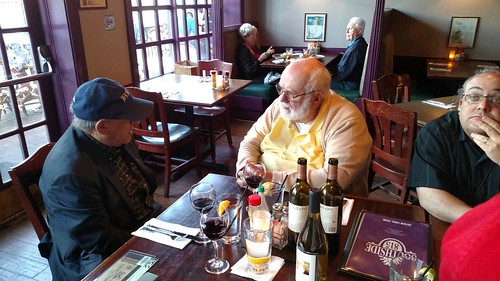
Joe Esposito, Gene Brandenburg, Eric Schena
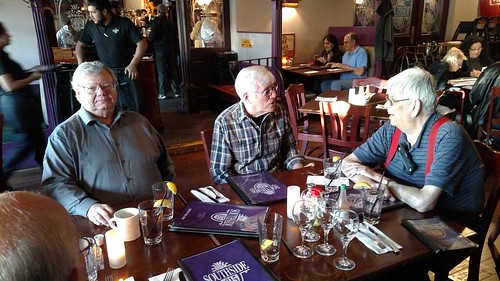
Roger, Dave, and Julian
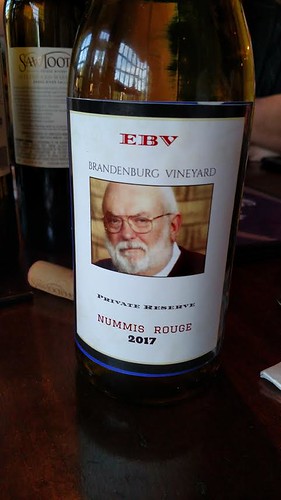 Gene loves his wine. He even has some to call his own. Joe Esposito writes:
Gene loves his wine. He even has some to call his own. Joe Esposito writes:
“Gene’s wine” was really a label that I designed and placed on a bottle of wine that I gave to Gene as a gag. This variety was identified as “Nummis Rouge.” He also now has more labels that he can use for the future.
Joe adds:
At dinner Mike Packard and I held a post-mortem on the Early American Coppers convention in Philadelphia, and we compared notes on our finds.
We all marvelled at how good the food was, particularly at such an unassuming-looking place. We've been there a few times now, and it's always been good. Eric adds:
I thought my burger was excellent - they prepared it perfectly and was a proper medium rare (a lot of places can't get that right). Next time, I want to try the red beans and rice - that looked and smelled great.
I didn't leave until after 9. Another great night of numismatic fellowship. I'm already looking forward to June.

CHOPMARK NEWS EXAMINES CHOPMARKED TRADE DOLLARS
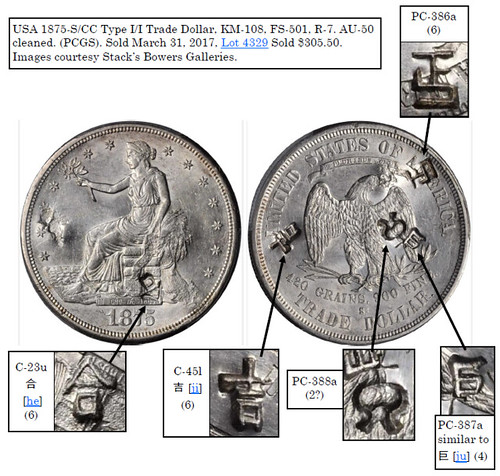
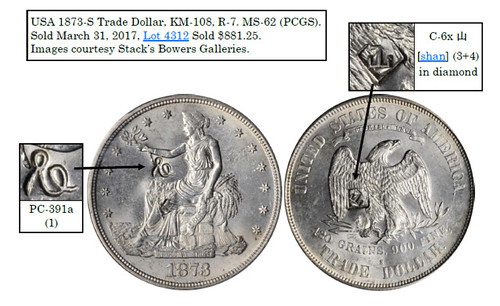
For more information about the Chopmark Collectors Club, see:
www.chopmarks.org
To read the earlier E-Sylum article, see:
STACKS BOWERS OFFERS CHOPMARKED TRADE DOLLARS (www.coinbooks.org/v20/esylum_v20n13a31.html)
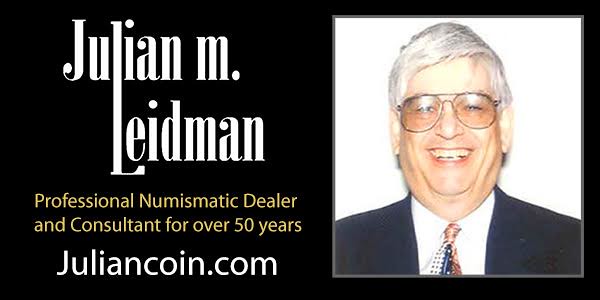
CHOPPED CHINESE COPPER CAST COINS
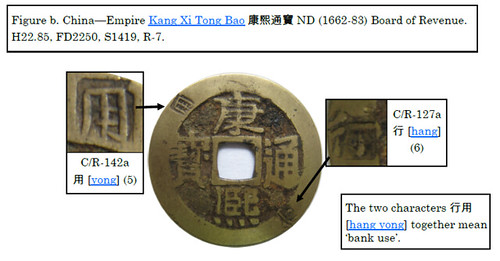
My interest in chopmarked Chinese cast coins was an accident. I started out collecting American silver dollars and it wasn’t too long until I discovered chopped US trade dollars. This opened up the fascinating world of chopmarked world silver coin collecting. After I moved to China for work, I started a type set collection of Chinese cast coins which spans al-most 2000 years of Chinese numismatic history (a very ambitious undertaking!). To my surprise, I soon noticed there were an abundance of chopped copper cast coins being offered in Chinese coin stores and auction web sites. It seemed only natural to combine my interest in chopmarks and Chinese cast coins together. I hope the following description of a selection of chopmarked coins from my collection will be of interest to the CCC community.
The first question to answer is why would the Chinese even chopmark these low value cop-per coins at all? Almost all examples of the host coins were of the lowest denomination cast coins, so unlike silver crowns, they would be hardly worth the shroffs’ time to check for authenticity. I have no first hand sources, but dealers and collectors from the two largest coin auction and discussion websites believe that in the past many kinds of businesses wanted to provide tokens or alternative currency for their customers, and the easiest way to do that was to use existing circulating coins and chop them.
Most businesses such as money exchangers and prototype banks (錢莊), however, simply chopped cast coins for their customers’ transactions. Similarly, other kinds of businesses chopped coins to be used as a sort of token for customers to spend. Some businesses or individuals even chopped their own names on these coins to be given to customers as a sort of “name card” or advertisement. American and British businesses of the 19th century had the identical practice of countermarking US large cents and British pennies for advertisement and making tokens.
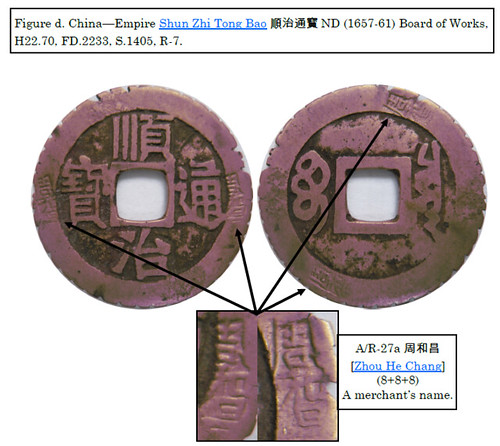
The variety of chopmarks are quite similar to ones found on silver coins consisting of incuse and relief types made up mostly of Chinese characters, symbols, and edge cuts. However, there are relatively more Chinese proper names and auspicious phrases on cast than on silver coins. Indeed the price that dealers quote seems to increase the more auspicious the phrase. Incidentally, I have never come across a cast coin with an ink chop. Chopmarks were usually struck on the outer rim of the coin and rarely in the field. Oftentimes a single chopmark would be repeated in a symmetrical pattern. Interestingly, wholly unlike silver coins, these coins are never found with different chopmarks from multiple businesses except for one exception....
Lastly, chopped cast coins can be found in coin stores in China, Hong Kong, and Taiwan, but are most easily found on Chinese coin auction websites. Unlike chopped silver coins which are sold at a discount and considered damaged, cast coins with chops are actually highly prized by Chinese collectors and may be three to five times more expensive than regular non-chopped coins. It is my hope that after reading this article, there may be more collectors outside of China who also appreciate these unique and fascinating coins.
For more information about the Chopmark Collectors Club, see:
www.chopmarks.org

DICK JOHNSON ON THE CURRENCY OPTIMIZATION ACT

CENT PROBLEM KICKED DOWN THE ROAD
The U.S. Treasury will abandon the cent, temporally at least, if new legislation proposed by Senators John McCain (AZ) and Michael Enzi (WY) is passed. Their bill (S759) calls for halting the production of cents (because of the cost of production is greater than face value of the coin). Also it calls for a search for a replacement composition for the nickel (also for savings) and diminishing the use of the paper dollar (for the greater use of the one dollar coin).
The law requires the cessation of striking the cent for ten years. After that time the Treasury could resume manufacture if it finds a suitable composition for the coin. (At present this is only paper or plastic. A decade’s time will not change that.)
The bill is called the “Currency Optimization, Innovation and National Savings Act of 2017.” If Congress really wanted to live up to the word “Innovation” it would consider my plan to revamp the entire coinage structure – not just one problem at a time -- as I have described in The E-Sylum before.
I proposed to eliminate both the cent and the nickel, and later the quarter. These coins to be replaced by two new denominations for circulation, a $5 and a $10 coin, and later a $20 coin. This would leave the dime, half dollar, and dollar coin denominations intact.
Not only is the reason for this the rising cost of metal in which the coins are struck, but also for the rise of the American economy. A loaf of bread cost a dime a century ago. Today it is two to three dollars. In the future it will rise to $5 or more.
It is a natural function of a vibrant economy for cost to gradually rise. As the cost of living rises so should income rise even faster. That increases our standard of living. Yes, we live better today, even though costs rise.
Am I saying we have a better living because of existing coin denominations? No, Coins facilitate commerce, acquiring and consumption of those goods. Coin denominations need to be the correct ranking to aid in the exchange of goods and services in commerce.
The cent is overdue for elimination. The nickel is close behind. The dime will be the lowest circulating coin. Prices will be rounded off to the nearest 10 cents. The complaint buyers will lose money is spurious. It balances out in the long run for both buyer and seller.
For the small cash purchase the dime, half and dollar coin will be satisfactory.
How does this affect collectors? The proposed law allows for the continued manufacture of cent coins for numismatic purposes. The cent could be allowed in proof and mint sets if the Treasury so chooses. Other Mint products would not be affected.
Obviously, it gives finality to the Lincoln cent series. A 108-year run with, perhaps, ten years of proof issues. Victor D. Brenner would be proud.
If the Treasury was pro active instead of reactive – addressing problems as they rise -- they could look forward into the future and realize our coin denominations need to be a higher value.
To read the bill and follow its progress, see:
S.759 - Currency Optimization, Innovation, and National Savings Act of 2017
(https://www.congress.gov/bill/115th-congress/senate-bill/759/text)
To read earlier E-Sylum articles, see:
DICK JOHNSON ON FUTURE COIN DENOMINATIONS (www.coinbooks.org/esylum_v10n28a23.html) http://www.coinbooks.org/esylum_v19n42a26.html (www.coinbooks.org/esylum_v19n42a26.html)
THE BOOK BAZARRE
TOY BANKS IN JUNE 2017 BERTOIA SALE
Over time, fine toys become historical objects as they pass from one prestigious collection to the next. That concept will be strikingly apparent at Bertoia Auctions’ June 2-3 Annual Spring Auction, which includes treasured toys from some of the greatest collections of all, including that of the late KB Toys co-founder Donald Kaufman
The mechanical and still bank selection is brimming with superior examples, such as a rare Germania bank with outstanding paint, and arguably one of the best of all known Darktown Battery banks, also in stellar condition. Approximately 50 still banks will be offered, with a variety of shapes replicating animals, people, whimsical subjects, and buildings. Of the latter, top pieces include an Ives Palace and a Kyser & Rex Apple.
Lot 303: Kicking Mule
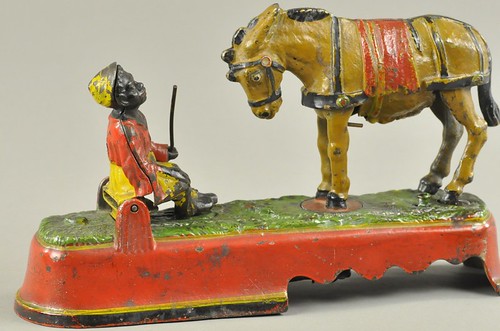
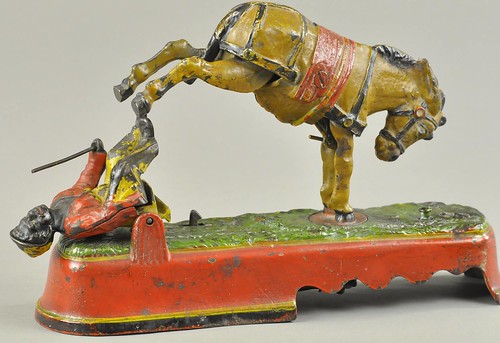
SPISE A MULE "BENCH" MECHANICAL BANK
red shirt, J & E Stevens Co., designed by James H. Bowne, patented 4/27/1897. When the mule and boy are brought into position, a slight touch on the knob at the base causes the mule to turn around
and kick the boy over, throwing the coin from the bench into the receptacle below
Lot 305: Paddy and the Pig
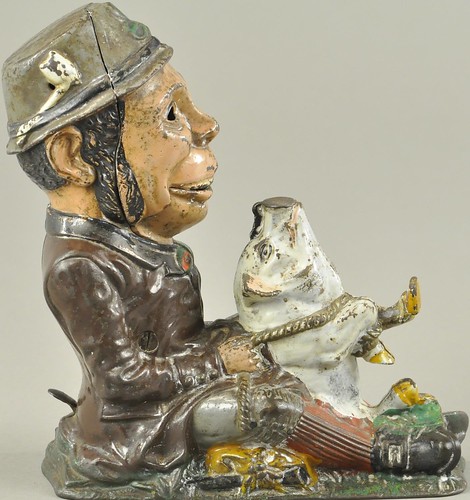
PADDY AND THE PIG MECHANICAL BANK - BROWN COAT
Brown coat, J & E Stevens Co., c.1885. Place coin on the nose of the pig and press the lever, pig will kick the coin as the man opens his mouth and swallows it; at the same time the eyes will
roll.
Lot 311: Ives Palace Still Bank
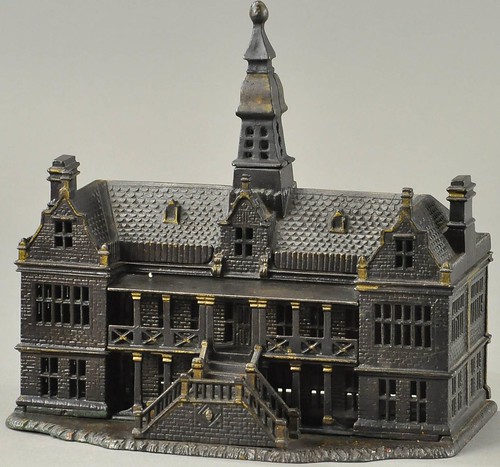
IVES PALACE STILL BANK
c.. 1885, familiar historical building done in extraordinary casting details are as crisp as the actual building, still considered by many to be the finest mold effects ever produced as a still bank.
7 1/2" x 8".
For more information on the sale, see:
http://www.bertoiaauctions.com/toy-auctions/june-2017-auction/3/

POLYMER BANKNOTES CUTTING DRUGGIE NOSES
 The new polymer bank notes appear to have had an unintended effect in stopping people snorting cocaine.
The new polymer bank notes appear to have had an unintended effect in stopping people snorting cocaine.
The plastic notes have been leaving people with cut noses after they use them to sniff the drug.
In the new phenomenon – called ‘getting Winstoned’ due to Churchill’s image appearing on the note – drug users are opening themselves up to all kind of infections.
The new texture of the new plastic note is a lot stiffer than the previous five-pound-notes which went out of circulation last Friday.
One Birmingham cocaine user, who did not want to be named, said: ‘I thought I was the only person to have had my nose cut by the new fiver.
‘But when I told my friend how I was in agony he said I had been “Winstoned” and it was happening to everyone.’
The news gets worse for those who have been ‘Winstoned’ as it could increase the spread of infection amongst users.
To read the complete article, see:
People are being ‘Winstoned’ by new £5 notes after snorting coke
(http://metro.co.uk/2017/05/11/people-are-being-winstoned-by-new-5-notes-after-snorting-coke-6627649/)
